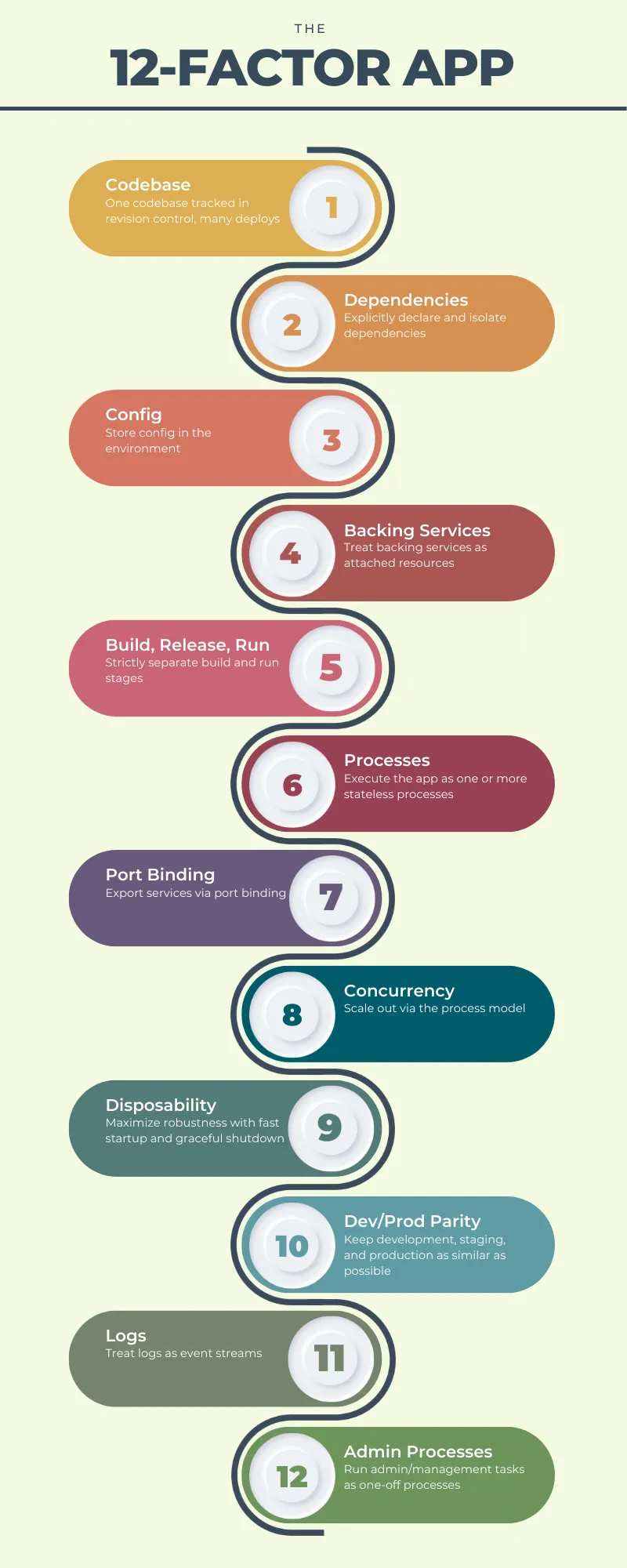Implementing 12-Factor App Principles with Kubernetes
Introduction
The 12-Factor App methodology is a set of best practices for building modern, scalable, and maintainable applications. It ensures that applications can be deployed and managed easily across different environments while providing a consistent experience for developers and users.

Kubernetes has emerged as a powerful container orchestration platform that simplifies application deployment, scaling, and management. Using Kubernetes, you can quickly implement the 12-Factor App principles in your applications. In this article, we’ll explore how to implement each of the 12 factors using Kubernetes.
Table of Contents:
- Codebase
- Dependencies
- Config
- Backing Services
- Build, Release, Run
- Processes
- Port Binding
- Concurrency
- Disposability
- Dev/Prod Parity
- Logs
- Admin Processes
- Conclusion
Codebase
One codebase tracked in revision control, many deploys
Maintain a single codebase for your application, and use version control systems(VCS) like Git to track changes. Kubernetes does not directly impact this factor but promotes a container-based development process where a single codebase can be deployed as multiple instances.
Dependencies
Explicitly declare and isolate dependencies
Use package managers and dependency management tools to manage your application’s dependencies. Leverage tools like Docker to package your application and its dependencies into a container image. Kubernetes uses these container images to deploy your application, ensuring that dependencies are isolated and explicitly declared.
Config
Store config in the environment
Use Kubernetes ConfigMaps and Secrets to store configuration data, such as environment variables and sensitive information. This allows you to separate configuration from your application’s code, making it easier to manage and deploy across different environments.
Backing Services
Treat backing services as attached resources
Kubernetes makes it easy to connect your application to backing services like databases, message queues, and caching systems through Services and Ingress resources. Furthermore, you can treat these backing services as attached resources and switch between them easily by updating your application’s configuration.
Build, Release, Run
Strictly separate build and run stages
Kubernetes encourages container images, inherently promoting the separation of build, release, and run stages. For example, you can use a CI/CD pipeline to build your container image, push it to a container registry, and then deploy it to your Kubernetes cluster.
Processes
Execute the app as one or more stateless processes
Design your application to be stateless, and use Kubernetes Deployments to manage the lifecycle of your application’s instances. Doing so allows you to scale your application horizontally and recover from failures.
Port Binding
Export services via port binding
Kubernetes Services allow you to expose your application’s ports to other components within the cluster or externally. By using Services and Ingress resources, you can implement port binding to export your application’s services.
Concurrency
Scale out via the process model
Kubernetes supports horizontal scaling of your application through Deployments and ReplicaSets. By designing your application to be stateless and using the process model, you can quickly scale your application to handle the increased load.
Disposability
Maximize robustness with fast startup and graceful shutdown
Ensure that your application can start quickly and shut down gracefully. Kubernetes supports readiness and liveness probes to determine the health of your application and manage its lifecycle accordingly.
Dev/Prod Parity
Keep development, staging, and production as similar as possible
Kubernetes promotes container images, which provide a consistent environment for your application across development, staging, and production. In addition, by using Kubernetes namespaces, you can easily separate and manage different environments within the same cluster.
Logs
Design your application to output logs as event streams, and use Kubernetes log aggregation tools like Fluentd, Logstash, or the built-in logging support provided by Kubernetes to collect process, and store log data. In addition, you can integrate with external logging services like Elasticsearch, Logz.io, or Splunk for better log management and analysis.
Admin Processes
Run admin/management tasks as one-off processes
Kubernetes supports running one-off tasks as Jobs or CronJobs, which allows you to run administrative tasks and management processes as separate, short-lived processes. By doing this, you can ensure that these tasks do not interfere with your application’s regular operation and can be managed independently.
Conclusion
Implementing the 12-Factor App principles with Kubernetes ensures your application is scalable, maintainable, and easy to deploy across different environments. By leveraging Kubernetes’ features, such as ConfigMaps, Secrets, Services, Deployments, and Jobs, you can build a modern application that adheres to these best practices, resulting in a robust and reliable system.
Subscribe to Faizan Bashir
Get the latest posts delivered right to your inbox
